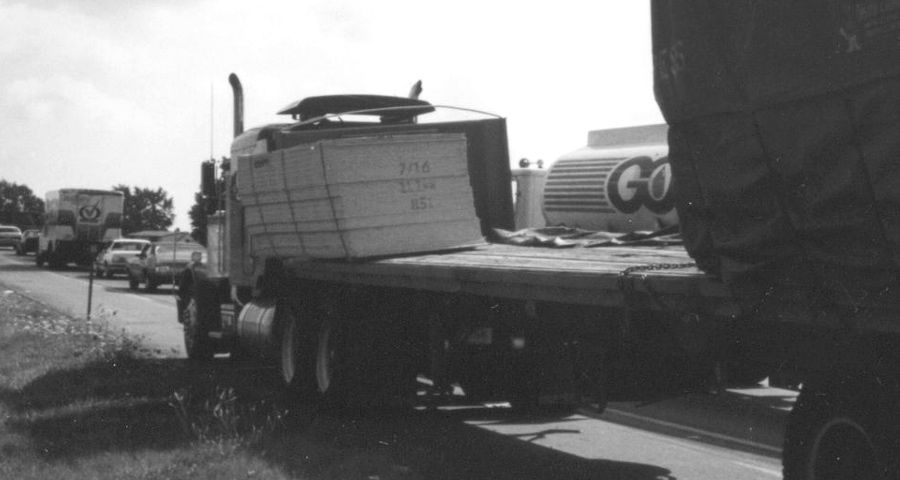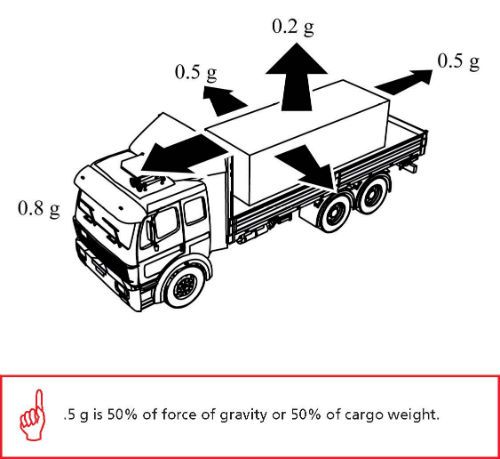Note: Your are not logged in. We can not keep your scores or track your progress unless you Register and Log In
What does the Standard require of the driver and carrier? (Section 2.3)
The following conditions must exist before a driver can operate a commercial motor vehicle and a carrier can require or permit a driver to operate a commercial motor vehicle:
- The commercial motor vehicle's cargo must be properly distributed and adequately secured.
-
The commercial motor vehicle's structure and equipment must be secured:
- Tailgate
- Doors
- Tarpaulins
- Spare tire
- Other equipment used in the vehicle's operation
- Cargo securing equipment.
-
The cargo or any other object must not:
- Obscure the driver's view ahead or to the right or left sides (except for drivers of self-steer dollies).
- Interfere with the free movement of the driver's arms or legs.
- Prevent the driver's free and ready access to accessories required for emergencies. OR
- Prevent the free and ready exit of any person from the commercial motor vehicle's cab or driver's compartment.
How Well Must Cargo be Secured?

So that it does not:
- Leak
- Spill
- Blow off the vehicle
- Fall from the vehicle
- Fall through the vehicle
- Otherwise become dislodged from the vehicle
- Shift upon or within the vehicle to such an extent that the vehicle's stability or maneuverability is adversely affected.
How well must the securement system work? (Section 1.3)
Each cargo securement system must be able to withstand a minimum amount of force in each direction.
- Forward Force = 80% of cargo weight when braking while driving straight ahead.
- Rearward Force = 50% of cargo weight when accelerating, shifting gears while climbing a hill, or braking in reverse.
- Sideways Force = 50% of cargo weight when turning, changing lanes, or braking while turning.
-
Upward Force = 20% of cargo weight when traveling over bumps in the road or cresting a hill.
- This requirement is satisfied when the cargo is "Fully Contained."

 Related Cargo Securement Terms That Every Driver Should Know:
Related Cargo Securement Terms That Every Driver Should Know:
-
g:
The acceleration due to gravity, 9.823 m/sec2 (32.2 ft/sec2). For cargo securement purposes it is expressed as a percentage of cargo weight, i.e. .5g is 50% of force of gravity or 50% of cargo weight.
-
Tarpaulin (tarp):
A waterproof sheet used to cover cargo.
-
Headboard:
A vertical barrier across the front of the deck of a vehicle to prevent forward movement of cargo.
Multiple-Choice Questions:
Cargo securement for a load weighing 37,000 lbs must be able to withstand a minimum forward braking force of:
- 7,400 lbs
- 29,600 lbs
- 18,500 lbs
- 10,000 lbs
How well must the securement system work? (Section 1.3)
Each cargo securement system must be able to withstand a minimum amount of force in each direction.
- Forward Force = 80% of cargo weight when braking while driving straight ahead.
- Rearward Force = 50% of cargo weight when accelerating, shifting gears while climbing a hill, or braking in reverse.
- Sideways Force = 50% of cargo weight when turning, changing lanes, or braking while turning.
-
Upward Force = 20% of cargo weight when traveling over bumps in the road or cresting a hill.
- This requirement is satisfied when the cargo is "Fully Contained."
What is a headboard?
- A vertical barrier placed directly behind the cab of a tractor to protect the cab in the event cargo should shift forward.
- A vertical barrier across a vehicle to prevent forward movement of cargo.
- A transverse load bearing structural component, particularly a part of a log bunk.
- A vertical barrier across the front of the deck of a vehicle to prevent forward movement of cargo.
Headboard:
A vertical barrier across the front of the deck of a vehicle to prevent forward movement of cargo.
When calculating directional forces, 'g' is expressed as:
- The summation of the working load limits or restraining capacity of all devices used to secure an article on a vehicle.
- The acceleration due to gravity, 9.823 m/sec2 (32.2 ft/sec2). For cargo securement purposes it is expressed as a percentage of cargo weight, i.e. .5g is 50% of force of gravity or 50% of cargo weight.
- The maximum load that may be applied to a component of a cargo securement system during normal service, usually assigned by the manufacturer of the component.
- The maximum load that may be applied to a component of a cargo securement system during normal service, usually assigned by the manufacturer of the component.
g:
The acceleration due to gravity, 9.823 m/sec2 (32.2 ft/sec2). For cargo securement purposes it is expressed as a percentage of cargo weight, i.e. .5g is 50% of force of gravity or 50% of cargo weight.
If you were instructed to 'tarp' a load, what would you be using?
- A short piece of material, usually wood, nailed to the deck to reinforce blocking.
- A strip of material that may be used to unitize articles and is tensioned and clamped or crimped back upon itself.
- A waterproof sheet used to cover cargo.
- A platform or tray on which cargo is placed so that it can be handled as an article.
Tarp:
A waterproof sheet used to cover cargo.
What is the minimum amount of rearward force that a cargo securement system must withstand?
- 20% of cargo weight
- 50% of cargo weight
- 100% of cargo weight
- 80% of cargo weight
Each cargo securement system must be able to withstand a minimum amount of force in each direction.
- Forward Force = 80% of cargo weight when braking while driving straight ahead.
- Rearward Force = 50% of cargo weight when accelerating, shifting gears while climbing a hill, or braking in reverse.
- Sideways Force = 50% of cargo weight when turning, changing lanes, or braking while turning.
-
Upward Force = 20% of cargo weight when traveling over bumps in the road or cresting a hill.
- This requirement is satisfied when the cargo is "Fully Contained."
While driving, the freight must not:
- Prevent the exit of a person from the cab.
- Interfere with the free movement of the driver's arms or legs.
- Obscure the driver's view ahead, left, or right.
- All of these things should be avoided.
- Obscure the driver's view ahead or to the right or left sides (except for drivers of self-steer dollies).
- Interfere with the free movement of the driver's arms or legs.
- Prevent the driver's free and ready access to accessories required for emergencies. OR
- Prevent the free and ready exit of any person from the commercial motor vehicle's cab or driver's compartment.
Complete!
You can Return To The Table Of Contents







 TT On Facebook
TT On Facebook